The Xiaomi Mi9 Review: Flagship Performance At a Mid-Range Price
by Andrei Frumusanu on September 13, 2019 9:00 AM EST- Posted in
- Mobile
- Smartphones
- Xiaomi
- Snapdragon 855
- Xiaomi Mi9
Display Measurement
The Mi9 comes with a 6.39” AMOLED panel sourced from Samsung, and features a 2340 x 1080 resolution.
In terms software settings, Xiaomi offers three screen modes; “Automatic contrast”, “Increased constrast” and “Standard”. Amongst the three, the standard setting is targeting the sRGB colour space, whilst the increased contrast is a non-standard gamut wider than DCI-P3 which looks to be the panel’s native gamut capabilities. Amongst the three colour spaces, Xiaomi also offers colour temperature tuning. I noticed that although the UI greys out the colour temperature settings for the Increased Contrast and Standard modes, the customized settings are actually still applied, even though they can only be adjusted when the Automatic mode is selected. For this review I stayed with the “Default” colour temperature pre-set as it was the best amongst the three pre-sets.
We move on to the display calibration and fundamental display measurements of the Mi9 screen. As always, we thank X-Rite and SpecraCal, as our measurements are performed with an X-Rite i1Pro 2 spectrophotometer, with the exception of black levels which are measured with an i1Display Pro colorimeter. Data is collected and examined using SpectraCal's CalMAN software.

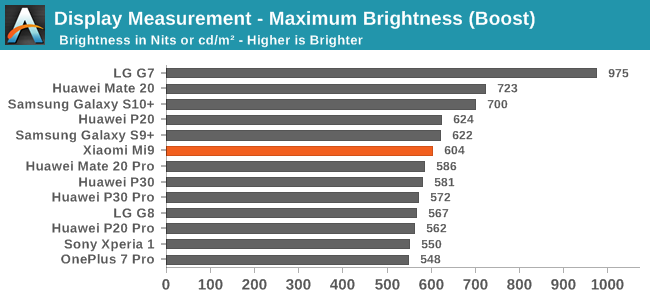
In terms of brightness, the Mi9 is on par with current generation AMOLED devices. At maximum manual brightness, the phone reaches a peak luminosity of 417nits. When in adaptive brightness and under bright environments, the phone goes into a high brightness mode and can reach up to 604 nits on a full screen white.
On the greyscale accuracy test, we’re seeing that the Mi9 is a little bit off in terms of gamma as well as colour temperature. The gamma reaches an average of 2.33 at the 200cd/m² brightness level. We’re measuring this data-point with APL50 and window size of 50%. We notice the gamma figure appears to be more accurate at the maximum brightness measurement set, but that set was performed at APL100, pointing out possible miscalibration of the gamma, something that sadly a very great number of vendors aren’t able to get right.
The colour temperature is also a bit on the warm side, with the reds dominating. This seems to get worse the brighter the panel gets, with white levels at 6463K at 200cd/m² and 6250K at 417cd/m². It’s to be noted that this is something that can be alleviated by the software colour temperature control, however the “Cool” preset is far too cool, and our measurements here are also just unique to the device we have at hand.
Overall, the redish tint might not be too noticeable, however tones will appear slightly darker than they should be due to the higher gamma.

The resulting greyscale accuracy ends up with a DeltaE2000 of 3.00, just at the limit of what should be acceptable.
The standard mode targeting sRGB has relatively accurate saturations and gamut targets. Notice that the increased gamma we measured on the greyscale test here doesn’t appear in the yellow and blue spectrum, albeit present on the mid saturation points of the red channel. Another inaccuracy also seems to be that the blue channel is off hue, causing a larger error also in the magenta colours, besides the whole redshifted gamut.

Still, with a deltaE2000 of 2.03, the results are quite ok and we’ve certainly seen worse from other devices.
I wanted to also showcase the saturations of the “Increased contrast” mode. The above graph targets the DCI-P3 gamut at gamma of 2.2 (Display P3), yet we clearly see that this mode’s gamut goes beyond the aforementioned standard. It doesn’t really adhere to any particular standard, and simply seems to be the OLED panel’s native large gamut with popping colours.
Finally, in the Gretag-Macbeth chart of commonly found tones and skin colours we see the results of the phone’s slightly too high gamma as well as the overall red-shifted colours.

Overall, the phone still managed to achieve a passable dE2000 of 2.68, which is not great, not terrible.
Overall, the Mi9’s screen is in my opinion a good screen. Contrast, brightness and viewing angles are again as usual of an OLED screen very good and the Mi9 doesn’t disappoint in this regard. In terms of colour calibration, the Mi9 did ok, we’ve certainly seen better calibrated devices out there but the Mi9 is also not outright bad. For users looking for the best accuracy I recommend the standard mode and trying to slightly adjust the colour temperature to their liking if they so happen to notice the slight red shift that appeared on our review device.


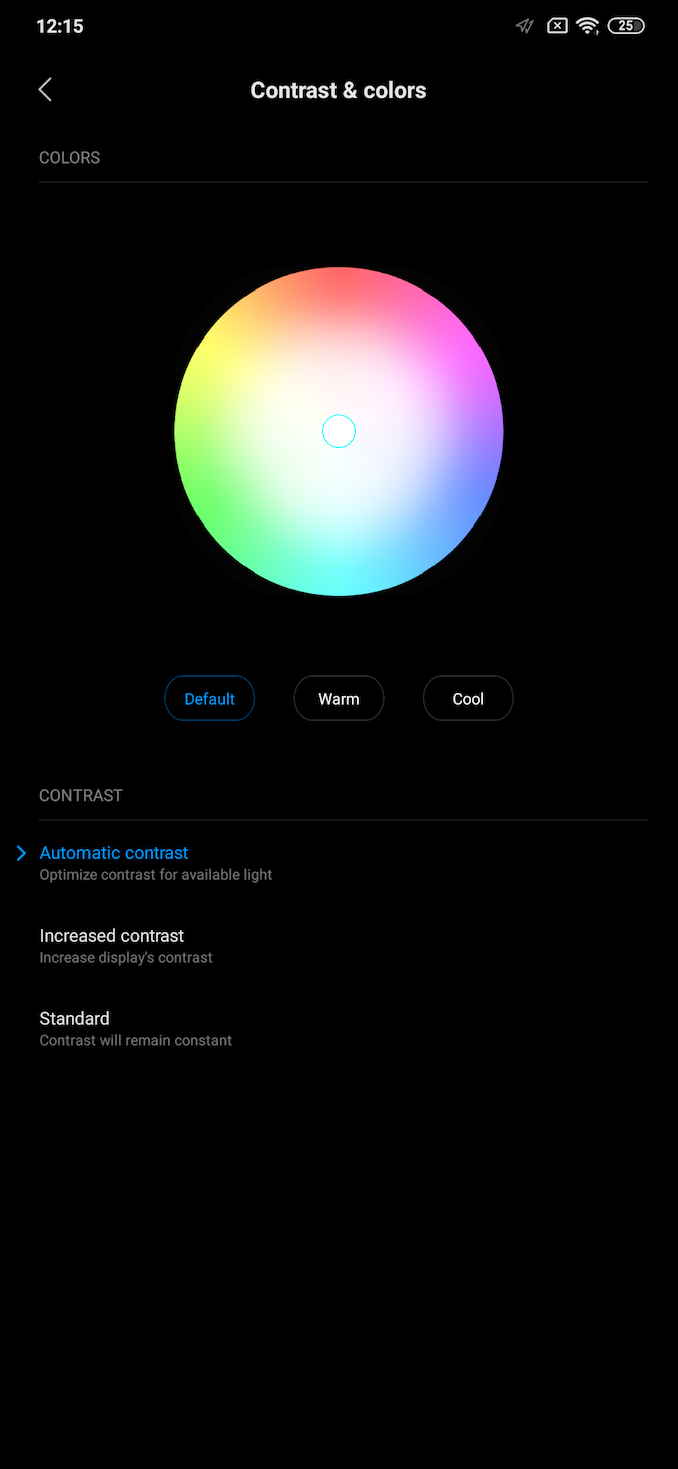
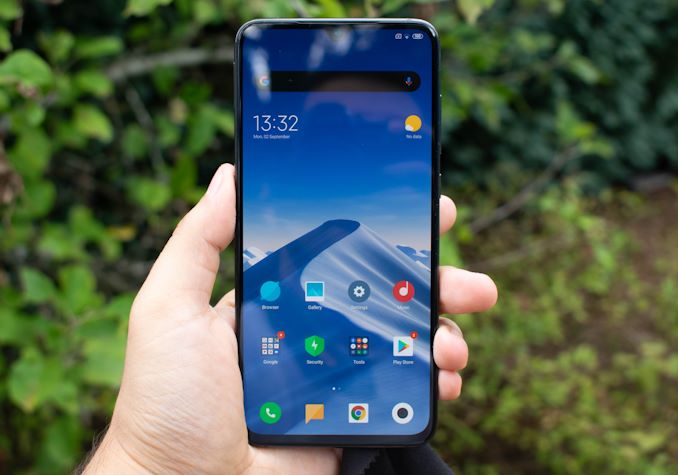


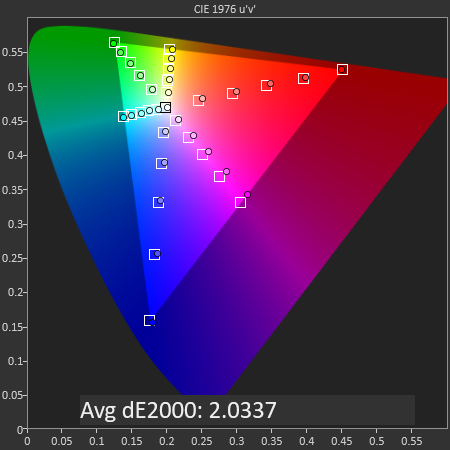
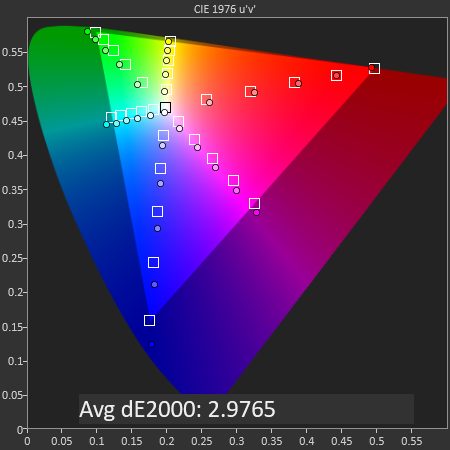
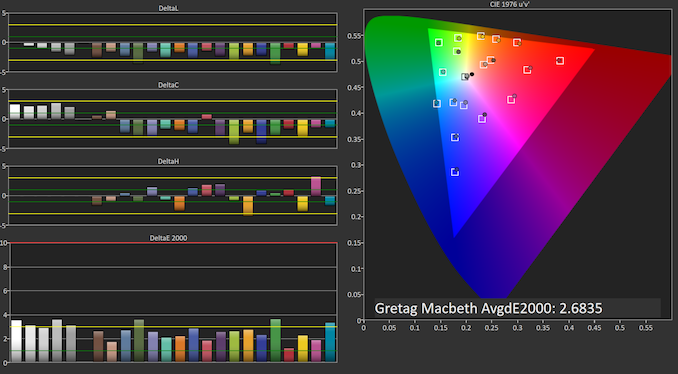








96 Comments
View All Comments
MrSpadge - Friday, September 13, 2019 - link
It's the built-in camera app, called "Kamera" as far as I can tell. However, I had a quick look and can't find any sharpening settings now either, so maybe they've removed that with some update.In order to load this .eu rom I'd have to reinstall everything not saved in the google account, right? If so: thanks, I'll keep it in mind for now.
Redmyth79 - Friday, September 13, 2019 - link
LOL, yeah I had it to until the update switched from 10.26 to 10.27 I believe it wasRedmyth79 - Friday, September 13, 2019 - link
I used to have the option on EU ROM to sharpen, Saturation, and contrast but after the 10.26-27 update I lost that ability and truthfully I'm pissed about that. But I still am using stock ROM as I have yet to unlock my boot loader although I can at anytime as I've had it sense mayElFenix - Friday, September 13, 2019 - link
52 mm lenses are not telephoto! it's just normal! quit calling it telephoto!Redmyth79 - Friday, September 13, 2019 - link
It has a telephoto equal to S10+, as it's actually a Samsung telephoto lens.ElFenix - Friday, September 13, 2019 - link
still not telephoto!Redmyth79 - Friday, September 13, 2019 - link
What ever you say master! It's telephoto in cellphone world!It's only a 2x not 3 or 5x optical but 2x the factory wide angle.
s.yu - Saturday, September 14, 2019 - link
It's telephoto if1. It's longer than normal, which it is not.
2. Its physical length is shorter than its focal length, which we don't know of, but is likely true.
NXTwoThou - Friday, September 13, 2019 - link
FYI, the wireless charging is 20W. So you can technically charge wirelessly faster than you can with the (global)included charger. China version came with the 27W charger and bought the 20W pad(and 20W car wireless auto grippy one) to go along with it.Awful - Friday, September 13, 2019 - link
It's a shame it wasn't the Mi 9T/Pro - as it really is a newer iteration on the Mi 9 - pretty much everything's improved from what I can tell. I've had mine for a few months now and the value is through the roof for what you get.Also noteworthy is just how easy/good GCam is on these - you can just download the APK and go (camera2 API already enabled so no messing round). It's nightmode and HDR+ fill in a lot of the weaknesses of the Xiaomi's camera app nicely.